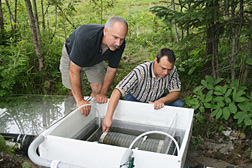|
Read the
magazine
story to find out more. |
|

ARS is exploring
cleaning drainage water originating from golf courses--and areas upstream of
golf courses--by attaching filter cartridges to drainage pipe and retention
pond outlets to filter out pollutants before they reach streams. Click the
image for more information about it.
|
|

|
From Golf to Gulf, Drainage Industry Greens
By Don
Comis January 13, 2009
A new idea being explored for cleaning drainage water originating on
and off golf courses is to attach a filter cartridge to drainage pipe and
retention pond outlets to filter out pollutants before they reach streams.
That's one approach being tested in an
Agricultural Research Service (ARS)
project bringing three industries together with agribusiness to clean drainage
water before it contributes to water quality problems downstream, such as the
Gulf of Mexico's "dead zone." The project participants are the turf industry,
the drainage industry, and the industrial products/byproducts industry.
Agricultural engineer
Kevin
King with the ARS
Soil
Drainage Research Unit in Columbus, Ohio, is testing the filter cartridges.
King uses commercial cartridges, filled with the typical water
cleansers used in drinking water treatment plants and home aquariums, as well
as industrial byproduct materials or materials often discarded as waste. He has
conducted tests on golf courses and watersheds in Texas and Minnesota and is
currently setting up a field test facility in Ohio. Preliminary results are
promising.
King and his colleagues are also testing water treatment facility
residues such as alum to improve the ability of fairway vegetative buffer areas
to filter out pollutants before they reach drainage pipe outlets. Alum is a
byproduct of the ammonia alum used for water purification.
Scientists at six ARS labs in five states are collaborating on the
project. The labs are in Ohio, Indiana, Minnesota, Pennsylvania and Maryland.
The idea is to join forces for mutual benefit--using industrial
byproducts from the wallboard industry, electric power plants, steel mills,
water treatment plants and other industries to clean drainage water. These
industries benefit by having an alternative to landfilling their byproducts. In
turn, they benefit the drainage industry, farmers, and the turf industry by
making sure discharge waters are clean for the next user and the environment.
And in some cases they can save water by re-using the cleansed water.
Read
more about this research in the January 2009 issue of Agricultural
Research magazine.
ARS is a scientific agency of the
U.S. Department of
Agriculture.